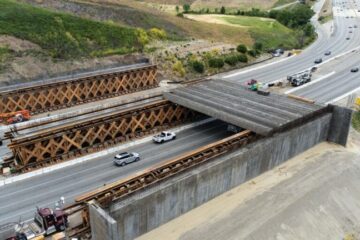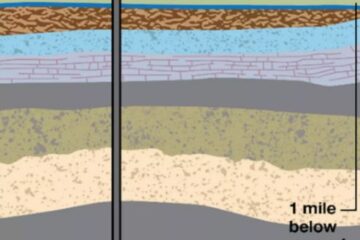Energy officials plan to move radioactive waste from near the Colorado, easing fears of tainted drinking water for millions downstream.
Energy officials plan to move radioactive waste from near the Colorado, easing fears of tainted drinking water for millions downstream.
Source of this article – Los Angeles Times, April 7, 2005.
By JANET WILSON, Times Staff Writer

HOT SPOT: Aerial foto shows pile of radioactive waste from abandoned uranium mill on banks of Colorado River near Moab, Utah
Department of Energy officials proposed Wednesday to move an enormous pile of radioactive waste off the banks of the Colorado River in southern Utah — to the great relief of politicians, environmentalists and Southern California water officials.
The 12 million tons of residue from an abandoned uranium mill sits in a floodplain of the Colorado, which provides drinking water to an estimated 25 million people downstream in Los Angeles, Las Vegas, Phoenix and other cities throughout the Southwest.
Last year, energy officials alarmed local residents, members of Congress, the Metropolitan Water District and others by indicating that the federal government might choose to cap the waste pile where it was. Energy officials said that option would be the least costly of several under consideration.
But Energy Secretary Samuel Bodman told his staff in a memo Wednesday morning that the “preferred alternative” would be to ship it to Crescent Junction — an arid, abandoned quarry site 30 miles to the north.
The U.S. Environmental Protection Agency told the Department of Energy last month that the option of leaving tons of radioactive waste next to the river was “environmentally unsatisfactory” and a potential prolonged risk to public health.
The EPA comments were part of mounting widespread opposition from Western governors, including Arnold Schwarzenegger in California, Republican and Democratic members of Congress, and others who said studies showed the pile could spill into the river during a rainstorm, contaminating drinking water for millions of people.
Wednesday’s announcement quelled many of those fears, although a final decision would not be made until later this year after a final environmental review.
“We are ecstatic…. This really is very, very important to us because of contaminates in the water in the Colorado River,” said Wes Bannister, chairman of the Metropolitan Water District. “You’re talking about a very well-known carcinogen, uranium … and it’s just something we just can’t let stay in the water.”
Sen. Dianne Feinstein (D-Calif.) expressed a similar view in a statement Wednesday.
“This is the right action … the only option that offers long-term protection to the citizens of Moab and the 25 million Americans who use the Colorado River water downstream.”
She added: “This is an important step forward, but the final decision is yet to be made. When the environmental review process is complete, I urge the Department of Energy to commit to off-site disposal of these dangerous toxic wastes.”
Bill Hedden, a longtime Moab resident who has fought since 1988 to have the pile moved, said he had been reassured by area Energy Department staff. “They called me this morning and said they were going to move it,” he said.
Hedden, executive director of the Grand Canyon Trust, an environmental group,added: “This is a great day for everybody who cares about the Colorado River. The daily insult of radioactive waste will be removed from the river, and the river will be protected from a catastrophic failure of the entire tailings pile.”
Larry Svoboda, a regional EPA official, said in a recent interview that the Crescent Junction site and one other possible destination north of Moab had several advantages over capping it in place close to drinking water supply.
“The environmental advantage is that they’ve got all the fill material right at that site that they’d need to build the pit and the lining,” he said.
In addition, “both of the northern sites are on this very dense, impermeable shale — it’s hard for water to get through. It’s very dry, and this area gets very little precipitation.”
Activists said floods this winter across the state on two smaller rivers brought home to officials how dangerous the Moab pile could be.
 “I think part of it was the terrible Hoods in St. George, Utah, which made people realize what a river out of control can do…. Two tiny little rivers just ripped the whole community away,” Hedden said.
“I think part of it was the terrible Hoods in St. George, Utah, which made people realize what a river out of control can do…. Two tiny little rivers just ripped the whole community away,” Hedden said.
“So when people put that together and said, gee, this 12 million tons of radioactive waste are right in the floodplain of the Colorado … then they realized the pile was in dire danger of being washed into the water supply for 26 million people.”
Under the proposal outlined by energy officials, the waste would be shipped out by rail car and buried in a covered, clay-lined hole, at a cost of as much as $540 million.
Energy officials estimated that capping the waste in place would cost about $166 million.
But Joette Langianese, a Grand County Council member who represents Moab, said those estimates left out potential long-term costs of cleaning up after a catastrophic flood if the pile, composed of tailings from an abandoned uranium mill, were to wash into the river.
Funding for the site has been increasing steadily in recent years. President Bush has requested $28 million for 2006.
Langianese has mixed feelings that the pile a mile from her house may finally be moving. “I’m thrilled. I’m just so excited,” she said. “It stands out in our environment like a sore thumb.”
But she and some of her neighbors are nervous about the process of moving the toxic pile out of town.
“It’s a tittle different than being in Southern California,” Langianese said. “We do have a little bit of anxiety here because we’re going to uncover all this waste. I am a little anxious about it, but I feel perfectly confident that the health of our county will not be jeopardized by the Department of Energy.”
Shipping probably would not begin until 2007, and could take until 2012 to complete. As many as 15,000 gallons of ammonia and other pollutants that currently leach into the water daily are being successfully treated. Energy officials said.


